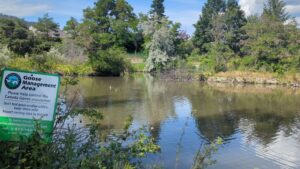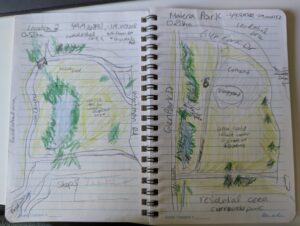Date: June 19, 2024
Time: 1540h
Location: Valley Glen Wetlands Park, within Brandts Creek Linear Park
Coordinates: 49.909512, -119.446294. Approx cross street, Valley Rd and Yates Rd.
Weather Conditions: 23C, mostly sunny, partly cloudy, no wind, no precipitation
The Organism of Study
The organism or biological attribute that I plan to study are the ducks in Brandts Creek Linear Park.
Observations
There are ducks that inhabit the Linear Park. Many of them are in the Valley Glen Wetland area; however, there are ducks in the various other holding ponds along Mill Creek. I noticed that the ducks appear to be throughout the park but appear to be more abundant in the areas where there is a holding area for water and human activity is physically slower.
I am using three sub-parks within Brandts Creek Linear Park. Site 1 is Valley Glen Wetland, Site 2 is Whitman Glen Park, and Site 3 is Matera Glen Park. All sites are of similar size. These sites all have a body of water, vegetation, walking paths, surrounding by urbanisation, and human activity at varying levels. Each area looks to be areas used in stormwater management.
Site 1 – Valley Glen Wetland – is 0.71ha is size. The pond takes a majority of the park. I would estimate it to cover 90% of the park. There are many ducks here consistently. Human activity is high; however, it is lower intensity or a short disturbance period.
Today there are 10 to 20 ducks in the wetland area. There are ducks in the water swimming and diving. There are ducks walking along the pathways and ducks fly in and out regularly in the 20-minute span of observation.

Site 2 – Whitman Glen Park – This park is the smallest is size at 0.53 ha. It has the second largest water source with a cover at an estimated at 25% of the park space. This area has a field space that appears to be a space for flooding when necessary. It is also used as a recreation area for dogs and people alike. There is also a high use walking path on the westside of the park along the westside of the pond embankment. This area has moderate paced activity with more off leash dogs and humans. The ducks in this park seem to be less and typically stay in the water more often and
Today there are two ducks in the pond swimming about. There are two ducks walking from a small holding pond about 20m south of the park. They walk into the park hang out. They eventually walk down to the pond and swim.
Site 3 – Matera Glen Park – This park is 0.83ha in size. The pond space covers an estimated 5% of the park area. The rest of the area is an open field that appears to be a flood management plain, approximately 65%, and children playground that is crushed rock and cement area, approximately 30%. The field is used recreationally by varying ages of humans and dogs. This park is a high use park and typically has higher levels of physical activity. Ducks in this park can be seen in the small pond and on the banks of the field regularly.
Today there are no ducks in the pond area, but there are 7 ducks in the field above the pond. A couple are lying down in the grasses above the pond. 4 ducks are walking further into the field and walking back towards the sitting ducks. As people walk close by the ducks do fly into the bushes along the creek, but then come back out and just stand about. Not one went into the pond during this observation.

Hypothesis
Ducks are abundant in areas where they have access to larger bodies of water and the human activity is slower paced.
Prediction
That Valley Glen Wetland will have more ducks than the other two parks. I believe site 2 and 3 will have ducks regularly, however, the park with the lower activities will have more ducks more regularly. The disturbance of humans is not a significant factor, it is the level of activity of the humans that determine where ducks reside.
Response Variable
The number of ducks in each park. This a continuous response variable.
Explanatory Variable
The presence of human activity and their level of exertion. The level of exertion will be based on common perception of exertion levels. Running, walking with a dog on leash are higher than walking alone. Unleashed dogs are similar to running humans. These are categorical variables.
First, I am not sure how you are measuring or categorizing human activity. It seems to be high or relatively high at all three sites based on your description and I am not clear what the difference is. Also, your two variables are confounding as pond size varies at each site and if human activity does as well than you only have one replication of each combination of variables. You would need multiple ponds at one size and varying levels of human activity to get at the influence of human activity. With only 3 sites and no ability to replicate then I would focus on only one variable. I think there are options here for you, but you need to think about how to measure your gradient and how to incorporate replication. You also need more details on how exactly you will measure human activity. Presence / absence, amount of activity, and level of exertion are all different pieces, I would focus on one. If you choose exertion, I don’t quite see how you will measure this as categorical. What if there are people that are running and walking at the same site. Is it automatically high exertion if there is even one person running?
Take a look at the tutorial on hypotheses and predictions again. I think your hypothesis is more about whether these factors influence duck abundance. Your prediction should be more specific and about your variables and not as much about your specific sites.